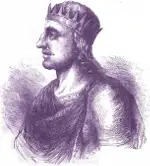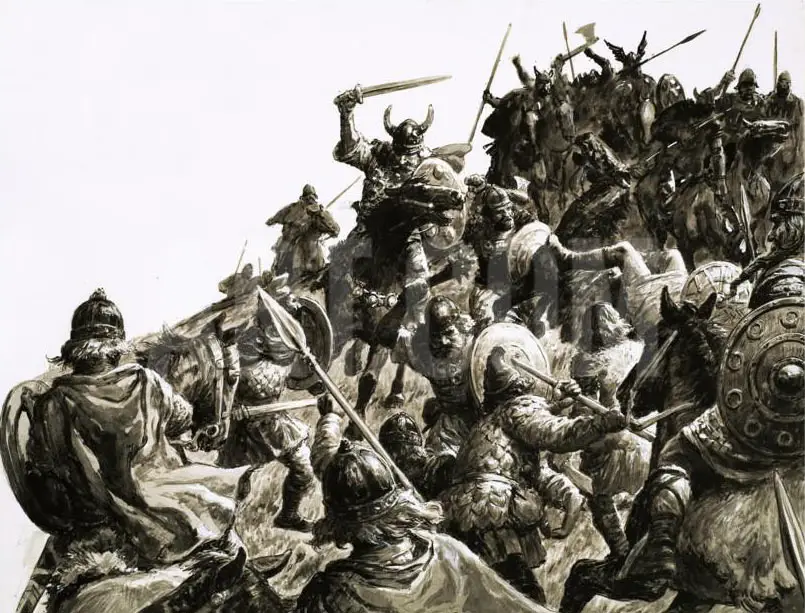|
|

9th-Century Kings of Wessex
|

|
|
|
Share This Page
|
|
|
|
|
|
|
Follow This Site

|
 |
|
|
|
|

|
Ruling the Anglo-Saxon Kingdom of Wessex in the 9th Century were a series of dynamic individuals, a handful of whom ruled much more than Wessex.
Egbert
Many historians regard Egbert, King of Wessex, as the first ruler of all England. The other Anglo-Saxon kingdoms accepted him as their overlord, making him a sort of unifying figure.

The history of Wessex contains many stories of commanding, unifying figures as kings. Egbert set about bringing the other kingdoms under his sway. He defeated King Beornwulf of Mercia at the Battle of Ellandun in 825, in what some sources describe as a titanic struggle. Egbert followed through on this victory four years later when he conquered Mercia itself, after defeating King Wiglaf of Mercia in battle. In that year, 829, he was proclaimed Bretwalda, or ruler of all England. He had earlier conquered Kent, Northumbria, Surrey, Sussex, and even Wales. Egbert died in 839; his oldest son, Æthelwulf, became King of Wessex.
Æethelwulf
 While essentially the crown prince and heir apparent, Æthelwulf defeated the Mercian king Beornwulf and ended that monarch's rule over another Anglo-Saxon kingdom, Kent. Son succeeded father atop the Wessex throne in 839, and the new ruler embarked on a relatively peaceful reign. Æthelwulf had been King of Kent (which also at that time included Essex, Surrey, and Sussex) while his father ruled Wessex; the new continued that practice, appointing his oldest son, Æthelstan, to rule Kent. While essentially the crown prince and heir apparent, Æthelwulf defeated the Mercian king Beornwulf and ended that monarch's rule over another Anglo-Saxon kingdom, Kent. Son succeeded father atop the Wessex throne in 839, and the new ruler embarked on a relatively peaceful reign. Æthelwulf had been King of Kent (which also at that time included Essex, Surrey, and Sussex) while his father ruled Wessex; the new continued that practice, appointing his oldest son, Æthelstan, to rule Kent.
Like many before and after him, he had his struggles with Viking raiders and settlers, striking defeat at Carhampton in 1843 but returning the favor with gusto at Aclea in 1851. The Anglo-Saxon Chronicle describes that battle as "the greatest slaughter of a heathen raiding-army that we have heard tell of up to the present day." In between, Æthelstan engineered a naval victory off the coast of Kent; he disappeared from the historical record not long afterward.
King »thelwulf embarked on a pilgrimage to Rome in 855 and left his oldest son, Æthelbald, to rule Wessex and his next-oldest son, Æethelbert, to rule Kent. After a year in Rome, Æthelwulf returned, bringing back a wife, Judith, whose father was Charles the Bald, the Frankish king, and whose grandfather was Charlemagne.
The Wessex king, new wife in tow, returned and found his oldest son unwilling to turn the throne back over to his father. To keep the peace, Æthelwulf let Æthelbald keep ruling Wessex and ruled from Kent, of which his next-oldest son had agreed to relinquish control. When Æthelwulf died in 858, he again handed the throne of Kent to Æthelbert. Æthelbald, meanwhile, continued as King of Wessex.
Æthelbald
 The new king married his stepmother, Judith; the marriage didn't last long. The king himself died two years into his reign, leaving little in the way of accomplishments. He had no coins issued in his name, as had his father before him and had his brother continued to do in Kent. Historical records contain no mention that he had children.
Æthelbert The new king married his stepmother, Judith; the marriage didn't last long. The king himself died two years into his reign, leaving little in the way of accomplishments. He had no coins issued in his name, as had his father before him and had his brother continued to do in Kent. Historical records contain no mention that he had children.
Æthelbert
 The next-oldest son of Æthelwulf, Æthelbert, had been ruling Kent for two years when his brother Æthelbald died. Æthelbert began his rule of Wessex in 860. He did not appoint either of his remaining brothers, Æthelred or Alfred, subking because they were both too young; rather, he ruled Wessex and Kent all on his own. The next-oldest son of Æthelwulf, Æthelbert, had been ruling Kent for two years when his brother Æthelbald died. Æthelbert began his rule of Wessex in 860. He did not appoint either of his remaining brothers, Æthelred or Alfred, subking because they were both too young; rather, he ruled Wessex and Kent all on his own.
Æthelbert's men went into battle against Vikings in the very first year of his sole reign. Invaders sacked Winchester in 860 but were subsequently turned away. A few years later, another Viking force rampaged around Kent for a time before being subdued.
The king himself died in 865; succeeding him was his next-oldest brother, Æthelred.
Æethelred I
 Taking over as King of Wessex in 865, Æthelred faced almost immediate danger, in the form of a large Viking army ravaging the countryside. He struggled against this army for the entirety of his reign. By 870, Viking strongmen were in charge in East Anglia and Northumbria. In that same year, they came after Wessex. Taking over as King of Wessex in 865, Æthelred faced almost immediate danger, in the form of a large Viking army ravaging the countryside. He struggled against this army for the entirety of his reign. By 870, Viking strongmen were in charge in East Anglia and Northumbria. In that same year, they came after Wessex.
The invaders had absorbed the north and the east, including Kent, and were making their way south and west. It was near the end of the year 870 that Danish longboats sailed up the River Thames toward Reading, a strategic place at the junction of the Thames and the River Kennet.
The Danes had no trouble taking Reading, and the English defenders fled to the west, to Englefield, on December 28. They attempted to retake the city on January 4 the following year but were repulsed. By this time, the call had gone out for reinforcements.
 The English force that took the field at the Battle of Ashdown on Jan. 8, 871, was rather large, as was the Danish force that opposed the English. King Æthelred was there, at the head of one half of the English force; commanding the other half was Alfred. The English force that took the field at the Battle of Ashdown on Jan. 8, 871, was rather large, as was the Danish force that opposed the English. King Æthelred was there, at the head of one half of the English force; commanding the other half was Alfred.
Early in the morning, the Danes set out to seize a hill that would give them command of the surrounding area. Alfred saw this and saw the need to move to intercept. Casting about for an order to attack, he found that his brother the king was busy leading his half of the army in a prayer meeting. Putting immediate need ahead of possible divine intervention, Alfred spurred his men on and engaged the enemy, charging up the hill with abandon.
Æthelred and the rest of the English force arrived a bit later, and the two halves became one. The battle lasted most of that day and at the end of it, it was the Danes who were retreating.
That success proved short-lived, as the Viking army defeated the Saxons at Basing, later that month, and then at Meretun, in March. Æthelred died in early April, and his younger brother, Alfred, took up the mantle of kingship.
Alfred the Great
 Alfred is one of the most of famous kings in English history. He organized his army and his people to rise up time and again against Viking armies, with (for him) the final result being a line of demarcation that came to known as the Danelaw. He directed the construction of a series of burhs, or fortified towns, to help defend against Danish counterattacks. He directed the building of ships, to counter Danish movements at sea. He reorganized the army on a rotating basis, so that farmers could be soldiers for a time and then go home to tend to their farms for a time as well, before rotating back into the army. He also oversaw the development of new schools and courts and added his own set of laws to an overhauled legal system. When he died, in 899, his brother, Edward, became king.
Edward the Elder Alfred is one of the most of famous kings in English history. He organized his army and his people to rise up time and again against Viking armies, with (for him) the final result being a line of demarcation that came to known as the Danelaw. He directed the construction of a series of burhs, or fortified towns, to help defend against Danish counterattacks. He directed the building of ships, to counter Danish movements at sea. He reorganized the army on a rotating basis, so that farmers could be soldiers for a time and then go home to tend to their farms for a time as well, before rotating back into the army. He also oversaw the development of new schools and courts and added his own set of laws to an overhauled legal system. When he died, in 899, his brother, Edward, became king.
Edward the Elder
 Edward was 31 when he took the throne of Wessex. He began his reign with a succession crisis, fighting against his cousin Æthelwold, son of Æthelred I. He had fought against the Viking armies, notably in a victory at Farnham in 893, and so was no stranger to battle. He defeated his cousin at 902 at the Battle of Holme and reigned without further internal struggle thereafter. Edward was 31 when he took the throne of Wessex. He began his reign with a succession crisis, fighting against his cousin Æthelwold, son of Æthelred I. He had fought against the Viking armies, notably in a victory at Farnham in 893, and so was no stranger to battle. He defeated his cousin at 902 at the Battle of Holme and reigned without further internal struggle thereafter.
Edward had two wives. The first wife, Ecgwynn, died not long after giving birth to Æthelstan. Edward married again, and his second wife, ÆelflfÆd, gave birth to Ælfweard.
Edward certainly had continued conflict against the Vikings, trading victory for defeat while also employing large sums of money to guarantee the peace. He directed the construction of a number of fortresses, along with his sister, Æethelflaed, Lady of the Mercians. The pair also oversaw the retaking of southern England in the 910s. When she died, her daughter Ælfwynn ruled for a time, but Edward eventually assumed the kingship of Mercia as well. He ended a revolt in Cheser in 924 and died in July of that year. Succeeding him was his oldest son, Æthelstan.
|
|